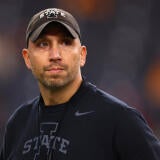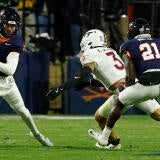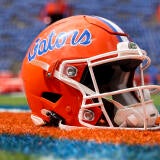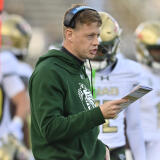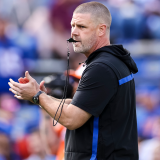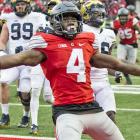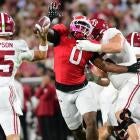25 things we learned from the unpredictable 2016 college football season
Just when we thought we had college football figured out, the rug was pulled out from under us again

To appreciate the twists and turns of a college football season, it's helpful to remember how it started. Think back to the lessons some people thought they learned after one of the most compelling Week 1s ever.
Take: Houston is going to the playoff.
Fact: Houston didn't win the AAC West division.
Take: Texas is back!
Fact: Texas beat 4-8 Notre Dame and later hired Houston's coach.
Take: The Big 12 is seriously moving toward expansion.
Fact: The Big 12 created a public circus and decided what everyone knew from the beginning: No candidate adds a lot of dollars.
Take: There's a big problem with Clemson's offense.
Fact: Week 1 opponent Auburn finished as a top-five scoring defense and Clemson had similar stats to 2015 except for a weaker running game.
Take: Same old Les Miles, same old LSU offense.
Fact: Yep.
Take: The SEC is down after seven of its teams lose their first game.
Fact: For the first time, only one SEC team finished with fewer than four losses.
Take: Alabama crushes Southern California and the champion has been decided before the season really starts.
Fact: Stay tuned.
As we head into the bowl season, let's reflect on what we actually think we've learned from 2016.
Conferences
1. Big Ten -- The year of chaos: Half of the top eight from the final College Football Playoff Rankings came from the Big Ten. Their records against each other: Ohio State 2-1, Penn State 2-1, Michigan 2-1, Wisconsin 0-3. The CFP Selection Committee was right to not simply pick Penn State by virtue of winning the Big Ten Championship Game. The Buckeyes' win at Oklahoma and Penn State's 39-point loss at Michigan simply cannot be ignored. With the SEC down, the Big Ten had the better group of coaches and took advantage as the best conference in 2016.
2. SEC -- The year of transition: For the first time in SEC history, the champion's quarterback is a true freshman (Jalen Hurts). Alabama is the SEC's first three-peat champion since Steve Spurrier's Fun 'N Gun days at Florida in the mid-1990s. The SEC, which has its least experienced group of head coaches in 52 years, is Alabama and Everyone Else. There's still great talent, as evidenced by the defensive end position (Myles Garrett, Derek Barnett, Jonathan Allen). But Saban has so thoroughly run through the SEC that there's no clear challenger or successor to him, just a lot of ex-Saban assistants trying to prove themselves. LSU didn't help SEC coaching depth by losing the Tom Herman sweepstakes. Tennessee's Butch Jones and Texas A&M's Kevin Sumlin will enter 2017 under pressure. They will either evolve like Gus Malzahn or stubbornly lose their jobs like Les Miles.
3. ACC -- The year of the QB: Five ACC quarterbacks finished in the top 20 nationally in pass efficiency rating -- more than the SEC, Big Ten and Pac-12 combined. Take a bow, Nathan Peterman (Pittsburgh), Mitch Trubisky (North Carolina), Jerod Evans (Virginia Tech), Deshaun Watson (Clemson) and Lamar Jackson (Louisville). That does't even count No. 28 Brad Kaaya (Miami), No. 38 Deondre Francois (Florida State) and No. 47 Eric Dungey (Syracuse). In the year of the QB in the ACC, Watson is a big reason why if anyone beats Alabama -- and that's a big if -- it will likely be Clemson.
4. Pac-12 -- The year of "I Love the '90s:" The conference flashed back 20 years with its division winners being Washington and Colorado -- national programs during the 1990s that fell on hard times for a while. For the first time since 2008, someone not named Stanford or Oregon won the Pac-12. This may just be the beginning Chris Petersen's dominance at Washington. He's only going to recruit better talent. Oregon and UCLA fell off the map. USC is in its longest Pac-12 title drought since 1916-26. Stanford rebounded from a slow start for a solid 9-3 season, but who can forget the Huskies' 44-6 beatdown of Stanford in September?
5. Big 12 -- The year of no defense (again): CFP chairman Kirby Hocutt got it right by candidly explaining why Oklahoma got left out: No defense. (As Texas Tech's athletic director, Hocutt knows all about this since the Red Raiders allowed an FBS-worst 43.5 points per game.) The Sooners went undefeated in the Big 12 despite ranking 75th nationally in scoring defense and 84th in yards per play. They got exposed badly out of conference against Ohio State and Houston. Bob Bowlsby doesn't need an explanation from the CFP on why the Big 12 is staying home for the second time in three years. He needs the Big 12 to recruit better and play some defense.
College Football Playoff
6. Stop looking for CFP messages: If schools and conferences want notes from the committee on how to make the playoff, the message is this: "Stop looking to us for messages." The committee's picks weren't nearly as controversial as some in the media made them out to be. A team's mulligan is gone once it loses two games, and a team can benefit by winning a strong nonconference game. Both statements can be true. Picking four teams is always going to be highly subjective. Flexibility from the committee year to year isn't necessarily bad since every season is different. Where the committee gets it wrong is by staging weekly mock rankings and making definitive statements that might not hold up in certain years. Ex-chairman Jeff Long stressed the value of conference championships so much in 2014 and 2015 that some in the public seemed to believe the committee was picking the four best conference champions.
7. Stop ranking the SEC so high: The SEC won't wither up and die after a down year. There's too much money, passion and talent there for that to happen. But if the CFP mock rankings must exist, it's past time to stop initially giving the SEC the benefit of the doubt. From 2014-16, five SEC teams that got picked in the top four of the CFP's first rankings combined to finish with a 10-16 record. Texas A&M, ranked No. 4 by the CFP on Nov. 1, became the latest SEC team to collapse. The first CFP Rankings this year for the four 2016 playoff teams: 1. Alabama, 2. Clemson, 5. Washington, 6. Ohio State. This was a very top-heavy season.
Players
8. Lamar Jackson is a freak athlete: In Week 1, Alabama running back Bo Scarborough (18 career carries) had better odds of winning the Heisman Trophy than Jackson. Oops. While Scarborough ran for 539 yards, Jackson accounted for 51 touchdowns, ran for 1,538 yards (eighth in FBS) and threw for 3,390 yards (12th). Jackson stumbled in the final two games, but he carried Louisville farther than most could have with his suspect offensive line and drops by receivers. Still, Jackson must improve his accuracy (80th in completion percentage). As the Heisman winner, he'll be judged against unattainable standards in 2017. That's the nature of the beast.
9. Derrius Guice might be next: Say hello to Guice, LSU's backup running back, who will be an under-the-radar player to watch in 2017. With Leonard Fournette being a week-by-week decision this year due to his health, Guice ran for 1,249 yards (7.96 yards per carry) and 14 touchdowns. He had two SEC games with more than 250 yards rushing, yet for some reason only touched the ball twice Nov. 8 against Alabama in a 10-0 loss. LSU's next offensive coordinator will have a special player.
Teams
10. On the rise for 2017: Could Virginia Tech be the next Washington? While ushering out a legend in Frank Beamer, AD Whit Babcock perfectly executed a no-nonsense search in 2015 to land Justin Fuente and keep terrific defensive coordinator Bud Foster to run a top-25 defense. The result was a 9-4 debut for Fuente, who returns promising quarterback Jerod Evans in 2017. The Hokies could return 15 starters from their team that lost a competitive ACC Championship Game to No. 2 Clemson, which travels to Virginia Tech for a regular-season game in 2017.
11. On the decline for 2017: The injury to quarterback Josh Rosen certainly didn't help, but UCLA (4-8) would have struggled no matter what by experimenting with a physical, pro-style offense. The Bruins ranked 127th out of 128 FBS teams in rushing yards per game, 96th in scoring and 92nd in total offense. UCLA was a trendy (and bizarre) preseason pick to make the playoff in 2015. Two seasons later, Jim Mora Jr. fired first-year offensive coordinator Kennedy Polamalu. Mora enters 2017 in a crucial sixth season that could be Rosen's final year in college.
Coaching changes
12. Charlie Strong to South Florida is significant: It would be nice to say we can ignore race when discussing football coaching hires. But in 2016, 54 percent of the players were black and 88 percent of the head coaches were white, so this topic can't be avoided. As I wrote last month, where Strong landed next after getting fired at Texas would say a lot about progress in hiring black coaches. Per the Washington Post, the Institute for Diversity and Ethics in Sport found that Tyrone Willingham is the only black coach to get fired from a major college football program and be hired again at another.
Schools shouldn't hire based on race. They do hire based on the comfort they feel with a candidate to do a good job. Comfort comes with face time. The more interviews minorities get with decision makers, the better chance they have to get hired in a sport where a lot of white men (presidents, athletic directors, boosters) call the shots.
13. Lane Kiffin runs out of options: Apparently, not even Saban can rehabilitate Kiffin in the job market. It shouldn't be a shock Houston promoted offensive coordinator Major Applewhite over hiring Kiffin. It's as if observers forget Kiffin was a 40-36 head coach at three jobs. He was accused of being a liar by Al Davis when he was fired in Oakland, created enthusiasm but also headaches in one year at Tennessee and took USC from preseason No. 1 to a 7-6 record before getting fired early the next season on the tarmac at Los Angeles International Airport.
Kiffin has done a terrific job developing three quarterbacks to win big at Alabama. He is a great offensive coordinator and seems to know it. That's a different skill set than head coach. You can't blame any school for being skeptical of turning over the keys to Kiffin given his track record. If he badly wants to be a head coach again, there's nothing wrong with going to a lower-profile school like Florida Atlantic.
14. P.J. Fleck might get left out, too: Of all the moves during this fairly quiet coaching carousel season, a 13-0 Western Michigan coach not leaving is one of the bigger surprises. Apparently ADs don't like Fleck as much as the media. Fleck seems intent on only leaving for a Power Five job, but he couldn't get Oregon. Maybe Fleck becomes 2017's version of Tom Herman by waiting a year and not jumping at just any job. Western Michigan plays at USC and Michigan State next season, so Fleck won't be off the map. But it's also a risk to stay given the talent Western Michigan is losing. When you're in the MAC, it never gets better than 13-0.
National trends
15. Rushing offenses continue to explode: For the first time, scoring eclipsed 30 points per game (30.2). Other FBS records set in 2016: rushing yards per carry (4.63), rushing yards per game (185.0), passing yards per attempt (7.4), total yards per game (414.8) and total yards per play (5.85). Dual-threat quarterbacks and run/pass option plays (RPOs) keep changing the game. Yards per carry have increased 15 percent since 2006. This stat was up just 1 percent from 1996-2006 and 4 percent from 1986-96 and it dropped 2 percent from 1976-86. College football hasn't witnessed rushing attacks this dominant over a 10-year period since the wishbone peaked in the 1960s-70s. Look for even more creativity in 2017 with RPOs.
16. Games got longer, plays stay the same: The average FBS game length was 3 hours, 24 minutes, up from 3:17 in 2015. The three-hour game has been gone for a while. Well, except at New Mexico State, which incredibly averaged exactly three hours as a woeful 3-9 team. Other teams that played quickly: Army (3:10), Boston College (3:10), Georgia Tech (3:11), Idaho (3:12) and Illinois (3:12). Teams that made their fans endure really long games: Oklahoma State (3:50), Texas Tech (3:48), Baylor (3:47), Texas (3:44), Tennessee (3:41) and Tulsa (3:40).
FBS teams ran 71.6 plays per game, right about where it has been since 2012. Most plays per game in 2016: Texas Tech (86.8), California (86.3), Tulsa (85.8), Baylor (85.4) and Houston (84.1). Fewest plays per game: Georgia Tech (58.8), Illinois (59.3), UTEP (61.3), Iowa (62.3) and LSU (62.5). If LSU finds itself on this list in 2017, Ed Orgeron clearly didn't land the offensive coordinator he promised.
17. More scoring equals more overtime: Twenty years after overtime debuted in major college football, 40 FBS games needed extra time in 2016. That's the second-most overtime games in a season, behind 45 in 2012. Since 2011, the FBS has averaged 38 overtime games compared to 30 from 1996-2010. More offense means fewer leads are safe so more chances to play extra football. Overtime is typically about mental and physical survival. Still, if coaches don't properly prepare for overtime these days with the right mindset and play calls, they're asking for trouble.
My awards
18. Player of the year: Lamar Jackson, Louisville. He was the most electric player in the country and dominated for a while without as much talent around him as other Heisman Trophy candidates.
19. Coach of the year: Chris Petersen, Washington. Colorado's Mike MacIntyre and Penn State's James Franklin enjoyed tremendous turnaround seasons, but I think people forget Washington was 7-6 in 2015, leaving Petersen's turnaround overshadowed because it was expected. That's how good he is.
20. Freshman of the year: Ed Oliver, Houston. Hurts showed terrific play-making skills and poise for Alabama, but we've seen Alabama win with different quarterbacks in the past. The nod goes to Oliver, a defensive tackle who's tied for ninth nationally in tackles for loss (19) and recorded five sacks. He lived up to the hype as the highest-rated recruit to choose a Group of Five school.
21. Play of the year (tie): Penn State's blocked field goal vs. Ohio State (Oct. 22). Marcus Allen's block followed by Grant Haley's scoop and long sprint for the score set in motion a wild Big Ten season in which the Buckeyes lost the battle but won the war.
Central Michigan's Hail Mary lateral vs. Oklahoma State (Sept. 10). Yes, Mike Gundy, we know officials shouldn't have let the play happen. But it did happen. And Cooper Rush to Jesse Kroll to Corey Willis was beautiful.
22. Catch of the year: Michigan cornerback Jourdan Lewis vs. Wisconsin (Oct. 1). If Lewis just knocked the pass down, it would have been amazing. The fact he hung in the air to catch the ball with one hand was ridiculous.
23. Run of the year: Ohio State's Curtis Samuel vs. Michigan (Nov. 26). Samuel weaved all over the field for a huge 8-yard gain on third-and-9 in the second overtime. He reversed field so much that he almost took Ohio State out of field goal territory to tie the game. Instead, he set up his winning touchdown moments later that sent Ohio State into the playoff.
24. Game of the year: Ohio State 30, Michigan 27 in double overtime (Nov. 26). Curtis Samuel weaved. (Where is he going?) J.T. Barrett lunged. (Did he or did he not get the first down?) Jim Harbaugh bitterly, bitterly complained. ("I was bitterly disappointed with the officiating.") Michigan-Ohio State was back as a game with huge stakes for both teams.
25. Quote of the year: "It's just a fact of business -- fact, f-a-c-k, fact." -- Michigan coach Jim Harbaugh, misspelling the word when discussing the difference between the thrill of victory and the agony of defeat. Fact: Harbaugh corrected himself, demonstrating that coaches, like Week 1 observers, eventually learned some facts in 2016.
Wink of the CBS eye to Landof10.com for the Curtis Samuel GIF



